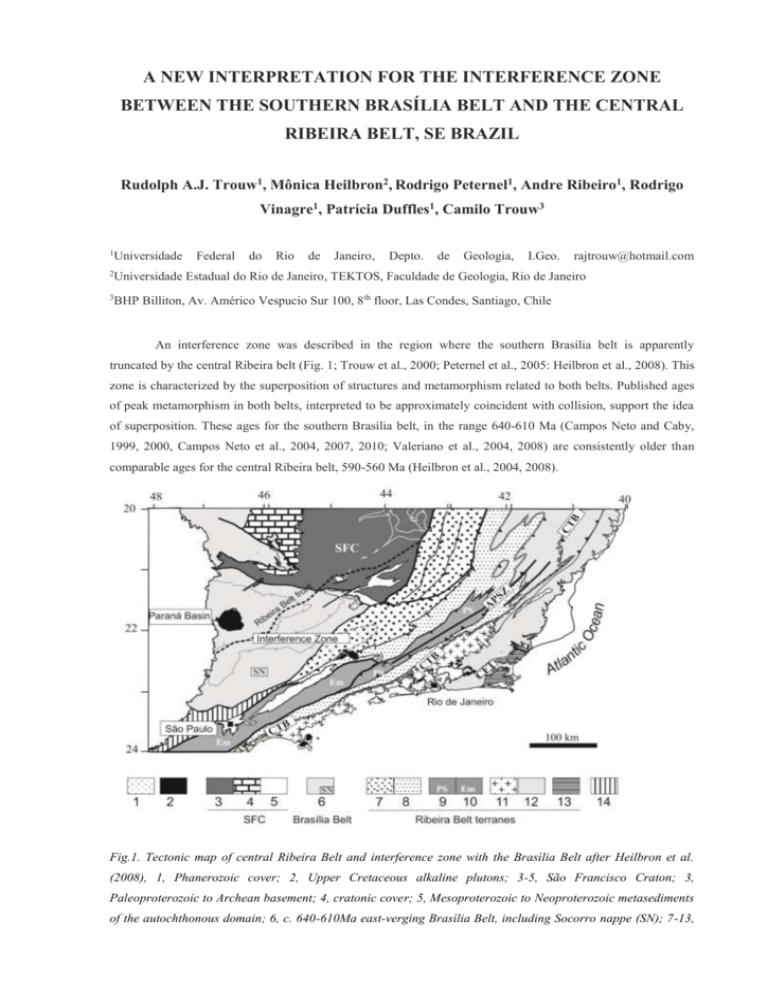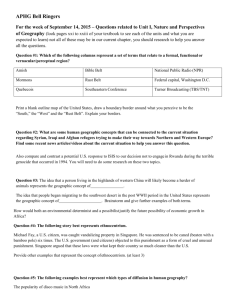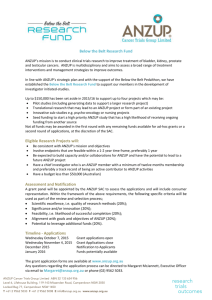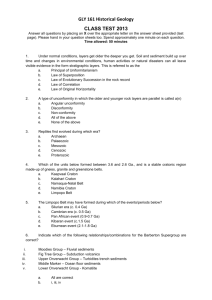a new interpretation for the interference zone between the southern
advertisement

A NEW INTERPRETATION FOR THE INTERFERENCE ZONE BETWEEN THE SOUTHERN BRASÍLIA BELT AND THE CENTRAL RIBEIRA BELT, SE BRAZIL Rudolph A.J. Trouw1, Mônica Heilbron2, Rodrigo Peternel1, Andre Ribeiro1, Rodrigo Vinagre1, Patrícia Duffles1, Camilo Trouw3 1 Universidade 2 Universidade Estadual do Rio de Janeiro, TEKTOS, Faculdade de Geologia, Rio de Janeiro 3 BHP Billiton, Av. Américo Vespucio Sur 100, 8th floor, Las Condes, Santiago, Chile Federal do Rio de Janeiro, Depto. de Geologia, I.Geo. rajtrouw@hotmail.com An interference zone was described in the region where the southern Brasília belt is apparently truncated by the central Ribeira belt (Fig. 1; Trouw et al., 2000; Peternel et al., 2005: Heilbron et al., 2008). This zone is characterized by the superposition of structures and metamorphism related to both belts. Published ages of peak metamorphism in both belts, interpreted to be approximately coincident with collision, support the idea of superposition. These ages for the southern Brasília belt, in the range 640-610 Ma (Campos Neto and Caby, 1999, 2000, Campos Neto et al., 2004, 2007, 2010; Valeriano et al., 2004, 2008) are consistently older than comparable ages for the central Ribeira belt, 590-560 Ma (Heilbron et al., 2004, 2008). Fig.1. Tectonic map of central Ribeira Belt and interference zone with the Brasília Belt after Heilbron et al. (2008), 1, Phanerozoic cover; 2, Upper Cretaceous alkaline plutons; 3-5, São Francisco Craton; 3, Paleoproterozoic to Archean basement; 4, cratonic cover; 5, Mesoproterozoic to Neoproterozoic metasediments of the autochthonous domain; 6, c. 640-610Ma east-verging Brasília Belt, including Socorro nappe (SN); 7-13, terranes of Ribeira Belt; 7, Andrelândia and 8, Juiz de Fora domains of Occidental terrane; 9, Paraíba do Sul terrane; 10, Embú terrane; 11, Neoproterozoic magmatic arc and 12, Neoproterozoic metasedimentary successions of the Oriental terrane; 13, Cabo Frio terrane; 14, Apiaí terane. CTB, Central Tectonic Boundary; CFT, Cabo Frio Thrust; APSZ, Além Paraíba Shear Zone. Dotted line indicates the thermal and deformational front of the Ribeira Belt at the interference zone with the Brasília Belt. Light-grey shaded area indicates approximately relicts of high pressure rocks related to the evolution of the Brasília Belt. A major question related to this interference zone remains open. How does the southern Brasília belt terminate? This belt was formed by the collision between the southern São Francisco paleocontinent, with its passive margin, that subducted below the active margin of the Paranapanema paleocontinent, now preserved as the Socorro-Guaxupé nappe (Fig. 1; Campos Neto and Caby, 1999, 2000: Trouw et al., 2000). The suture of this collision is located directly below the Socorro Guaxupé nappe (Trouw et al., 2000) or further down in the flat lying nappe pile, below the Andrelândia Nappe System (Campos Neto et al., 2007, 2010). On several published maps (Campos Neto et al., 2004, 2007, 2010) a large dextral shear zone cuts off the southern Brasília belt, including its suture, along the contact with the central Ribeira belt. Since no continuation of the dislocated southern Brasília belt, south of the shear zone, is shown, from a geotectonic point of view the shear zone has to represent a paleotransform fault and the region south of it should represent another plate. Fig. 2. Tectonic map of the transition zone between the southern Brasília Belt and the central Ribeira Belt: 1Phanerozoic sedimentary basins; 2- K-T alkaline rocks. 3- Basement of São Francisco Craton; 4- Sedimentary cover of São Francisco Craton; 5- Metasediments of autochthonous domain. Brasilia Orogen: 6- Lower Nappes; 7-Socorro-Guaxupé Nappe; 8- Embú-Paraíba do Sul terranes; 9- Apiaí Terrane. Ribeira Orogen: 10- external domain and 11- Juiz de Fora Domain of the Occidental Terrane. Oriental Terrane: 12- Rio Negro Arc; 13Neoproterozoic metasedimentary successions;. 14- Cabo Frio Terrane. The central Ribeira belt resulted from the collision between the southern São Francisco paleocontinent with its passive margin being the lower plate, and the Rio Negro Magmatic Arc, towards the southeast, being the upper plate (Heilbron et al., 2004, 2008; Tupinambá et al., 2000). The suture is the Central Tectonic Boundary (Fig. 1), and is situated further south, not intercepting the suture of the southern Brasília belt (Fig. 1). This leaves a considerable elongated body of crustal rocks between the shear zone in the north and the suture in the south without clear paleocontinental affinity. Looking at this body from the northeast, it seems to be an extension of the São Francisco paleocontinent because here it grades into the Juiz de Fora domain, defined by Heilbron et al. (2004) as basement interleaved with passive margin metasediments belonging to the São Francisco paleocontinent. However, looking at the same body from the southwest, it seems either to be part of the Paranapanema paleocontinent, or to be an isolated suspect terrane, separated from the Socorro-Guaxupé nappe by yet another suture, now the shear zone. This unresolved question motivated us to extend the detailed mapping practised by our group for many years in the region further to the northeast into the region considered here. The results of this mapping led to the surprising new interpretation presented below, that was tested with the help of U-Pb geochronology in zircon. Detailed mapping in the region between Itajubá, Campos de Jordão, Pindamonhangaba and Lorena showed a gradual transition between the Socorro nappe and the Embu terrane (Fig. 2). Both contain orthogneisses and/or metagranitoid bodies with ages in the range 670-600 Ma and chemistry consistent with an arc setting, surrounded by metasediments, mainly biotite schists and gneisses. In both the nappe and the terrane fragments of paleoproterozoic basement are also present. The “contact” is in our opinion the transition from the predominance of metagranitoids (Socorro nappe) to the predominance of metasediments (Embu terrane). Important shear zones are present close to and locally along the contact, but the rock units on both sides are equal and comparison with similar shear zones further to the NE (e.g. Trouw et al., 2008) led us to the interpretation that the offset along them is probably not more than several tens of kilometres. The new interpretation is that the Socorro-Guaxupé nappe grades into the Embú terrane and continues into the Paraíba do Sul terrane. This last equivalence was also proposed by Heilbron et al. (2008). In this conception the central Ribeira belt would have two sutures: 1) the continuation of the suture of the Brasília belt, along the base of the Socorro-Guaxupé nappe (sutured in this area between 620 and 600 Ma; Campos Neto et al., 2007, 2010), that would catch up with the base of the Paraiba do Sul terrane, and 2), the Central Tectonic Boundary, separating the Rio Negro Arc to the south (sutured between 590 and 560 Ma, Heilbron et al., 2004, 2008; Figs. 1 and 2). The distribution of metamorphic zones over the whole region considered reforces the idea of the continuation of the southern Brasília belt into the central Ribeira belt, because the medium pressure upper amphibolite to granulite facies is continuous from the Socorro-Guaxupé nappe into the Embú-Paraíba do Sul terranes, representing the upper plate with a magmatic arc in the age interval 670-600 Ma. To the north, separating this active margin from the São Francisco Craton is a belt of kyanite bearing relatively high pressure metasediments, including the Andrelândia Nappe System. On the other side, to the southwest, the Ribeira belt grades to greenschist facies and different rock types in the state of São Paulo, because this part is progressively more distant from both sutures. References Campos Neto, M.C., Caby, R. 1999. Neoproterozoic high-pressure metamorphism and tectonic constraint from nappe system south of the São Francisco Craton, southeast Brazil. Precambrium Research, 97, 3-26. Campos Neto, M.C., Caby, R. 2000. Lower crust extrusion and terrane accretion in the Neoproterozoic nappes of southeast Brazil. Tectonics, 19, 669-687. Campos Neto, M. C. , Basei, M. A. S. , Vlach, S.R.F., Caby, R., Szabo, G.A J., & Vasconcelos, P. 2004. Migração de Orógenos e Superposição de Orogêneses: Um esboço da Colagem Brasiliana no Sul do craton do São Francisco, SE -Brasil. Boletim do Instituto de Geociências/USP, São Paulo, Brasil, 4, 13-40. Campos Neto, M.C., Janasi, V.A., Basei, M.A.S., Siga Junior, O. 2007. Sistema de Nappes Andrelândia, setor oriental: Litoestratigrafia e posição estratigrafica. Revista Brasileira de Geociências 37 (4-suplemento), 4760. Campos Neto, M.C., Cioffi, C.R., Moraes, R., Motta, R.G., Siga Jr, O., Basei, M.A.S. 2010. Structural and metamorphic control on the exhumation of high-P granulites: The Carvalhos Klippe example, from the oriental Andrelândia Nappe System, southern portion of the Brasília Orogen, Brazil. Precambrian Research, 180, 125-142. Heilbron, M., Pedrosa-Soares, A.C., Campos Neto, M., Silva, L.C., Trouw, R.Aj. & Janasi, Vc. 2004a. A Província Mantiqueira: IN O Desvendar de um Continente: A Moderna Geologia da América do Sul e o Legado da Obra de Fernando Flávio Marques de Almeida (Mantesso-Neto, V., Bartorelli, A., Carneiro, C.D.R., Brito Neves, B.B., eds), XIII, 203-234. Heilbron, M., Valeriano, C.M., Tassinari, C.C.G., Almeida, J.C.H., Tupinamba, M., SIGA, O. & Trouw, R.A.J. 2008. Correlation of Neoproterozoic terranes between the Ribeira Belt, SE Brazil and its African counterpart: comparative tectonic evolution and open questions. In: Pankhurst, R.J., Trouw, R.A.J., Brito Neves, B.B. & de Wit, M.J. (eds) West Gondwana: Pre-Cenozoic Correlations Across the South Atlantic Region. Geological Society, London. Special Publications, 294, 211-238. Peternel, R., Trouw, R.A.J. & Schmitt, R.S. 2005. Interferência entre duas faixas móveis Neoproterozóicas: o caso das faixas Brasília e Ribeira no sudeste do Brasil. Revista Brasileira de Geociências 35 (3), 297-310. Trouw, R.A.J., Heilbron, M., Ribeiro, A., Paciullo, F.V.P., Valeriano, C.M., Almeida, J.C.H., Tupinambá, M. & Andreis, R.R., 2000. The central segment of the Ribeira Belt. In: Tectonic Evolution of South America, Cordani, U.G, Milani, E.J. and Thomaz Filho, A. (eds), 287-310. Trouw, C.C., Medeiros, F.F.F. and Trouw, R.A.J. 2007. Evolução tectônica da Zona de Cisalhamento Caxambu, MG. Revista Brasileira de Geociências 37, 767-777. Tupinambá, M., Teixeira W. & Heilbron, M. 2000. Neoproterozoic Western Gondwana assembly and subduction-related plutonism: the role of the Rio Negro Complex in the Ribeira Belt, South-eastern Brazil. Revista Brasileira de Geociências, 30, 7-11. Valeriano, C.M., Machado, N., Simonetti, A., Valladares, C.S., Seer, H.J. & Simões, L.S. 2004. U–Pb Geochronology of the Southern Brasília belt (SE Brazil): Sedimentary Provenance, Neoproterozoic Orogeny and Assembly of Western Gondwana. Precambrian Research, 130, 27-55 Valeriano, C.M., Pimentel, M.M., Heilbron, M., Almeida, J.C.H. & Trouw, R.A.J. 2008. Tectonic evolution of the Brasília Belt, Central Brazil, and early assembly of Gondwana. In: Pankhurst, R.J., Trouw, R.A.J., Brito Neves, B.B. & de Wit, M.J. (eds) West Gondwana: Pre-Cenozoic Correlations Across the South Atlantic Region. Geological Society, London. Special Publications, 294, 197-210.






